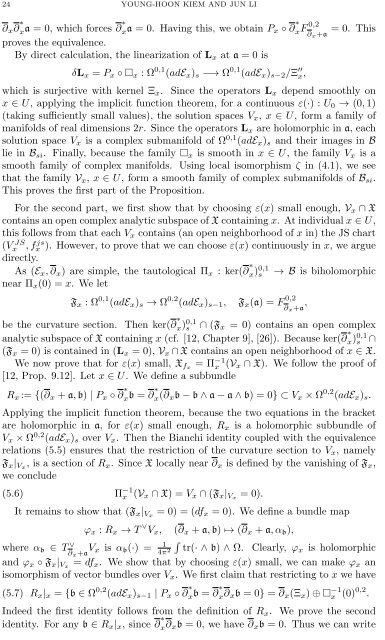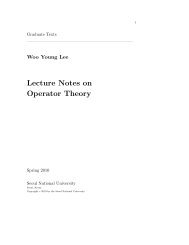Categorification of Donaldson-Thomas invariants via perverse ...
Categorification of Donaldson-Thomas invariants via perverse ...
Categorification of Donaldson-Thomas invariants via perverse ...
You also want an ePaper? Increase the reach of your titles
YUMPU automatically turns print PDFs into web optimized ePapers that Google loves.
24 YOUNG-HOON KIEM AND JUN LI∂ x ∂ ∗ xa = 0, which forces ∂ ∗ xa = 0. Having this, we obtain P x ◦ ∂ ∗ xF 0,2proves the equivalence.By direct calculation, the linearization <strong>of</strong> L x at a = 0 isδL x = P x ◦ □ x : Ω 0,1 (adE x ) s −→ Ω 0,1 (adE x ) s−2 /Ξ ′′x,∂ x+a= 0. Thiswhich is surjective with kernel Ξ x . Since the operators L x depend smoothly onx ∈ U, applying the implicit function theorem, for a continuous ε(·) : U 0 → (0, 1)(taking sufficiently small values), the solution spaces V x , x ∈ U, form a family <strong>of</strong>manifolds <strong>of</strong> real dimensions 2r. Since the operators L x are holomorphic in a, eachsolution space V x is a complex submanifold <strong>of</strong> Ω 0,1 (adE x ) s and their images in Blie in B si . Finally, because the family □ x is smooth in x ∈ U, the family V x is asmooth family <strong>of</strong> complex manifolds. Using local isomorphism ζ in (4.1), we seethat the family V x , x ∈ U, form a smooth family <strong>of</strong> complex submanifolds <strong>of</strong> B si .This proves the first part <strong>of</strong> the Proposition.For the second part, we first show that by choosing ε(x) small enough, V x ∩ Xcontains an open complex analytic subspace <strong>of</strong> X containing x. At individual x ∈ U,this follows from that each V x contains (an open neighborhood <strong>of</strong> x in) the JS chart(VxJS , fx js ). However, to prove that we can choose ε(x) continuously in x, we arguedirectly.As (E x , ∂ x ) are simple, the tautological Π x : ker(∂ ∗ x) 0,1s → B is biholomorphicnear Π x (0) = x. We letF x : Ω 0,1 (adE x ) s → Ω 0,2 (adE x ) s−1 , F x (a) = F 0,2∂ x+a ,be the curvature section. Then ker(∂ ∗ x) 0,1s ∩ (F x = 0) contains an open complexanalytic subspace <strong>of</strong> X containing x (cf. [12, Chapter 9], [26]). Because ker(∂ ∗ x) 0,1s ∩(F x = 0) is contained in (L x = 0), V x ∩ X contains an open neighborhood <strong>of</strong> x ∈ X.We now prove that for ε(x) small, X fx = Π −1x (V x ∩ X). We follow the pro<strong>of</strong> <strong>of</strong>[12, Prop. 9.12]. Let x ∈ U. We define a subbundleR x := {(∂ x + a, b) | P x ◦ ∂ ∗ xb = ∂ ∗ x(∂ x b − b ∧ a − a ∧ b) = 0} ⊂ V x × Ω 0,2 (adE x ) s .Applying the implicit function theorem, because the two equations in the bracketare holomorphic in a, for ε(x) small enough, R x is a holomorphic subbundle <strong>of</strong>V x × Ω 0,2 (adE x ) s over V x . Then the Bianchi identity coupled with the equivalencerelations (5.5) ensures that the restriction <strong>of</strong> the curvature section to V x , namelyF x | Vx , is a section <strong>of</strong> R x . Since X locally near ∂ x is defined by the vanishing <strong>of</strong> F x ,we conclude(5.6) Π −1x (V x ∩ X) = V x ∩ (F x | Vx = 0).It remains to show that (F x | Vx = 0) = (df x = 0). We define a bundle mapϕ x : R x → T ∨ V x , (∂ x + a, b) ↦→ (∂ x + a, α b ),where α b ∈ T ∨ V ∫∂x is α b (·) = 1x+a 4π tr(· ∧ b) ∧ Ω. Clearly, 2 ϕx is holomorphicand ϕ x ◦ F x | Vx = df x . We show that by choosing ε(x) small, we can make ϕ x anisomorphism <strong>of</strong> vector bundles over V x . We first claim that restricting to x we have(5.7) R x | x = {b ∈ Ω 0,2 (adE x ) s−1 | P x ◦ ∂ ∗ xb = ∂ ∗ x∂ x b = 0} = ∂ x (Ξ x ) ⊕ □ −1x (0) 0,2 .Indeed the first identity follows from the definition <strong>of</strong> R x . We prove the secondidentity. For any b ∈ R x | x , since ∂ ∗ x∂ x b = 0, we have ∂ x b = 0. Thus we can write













